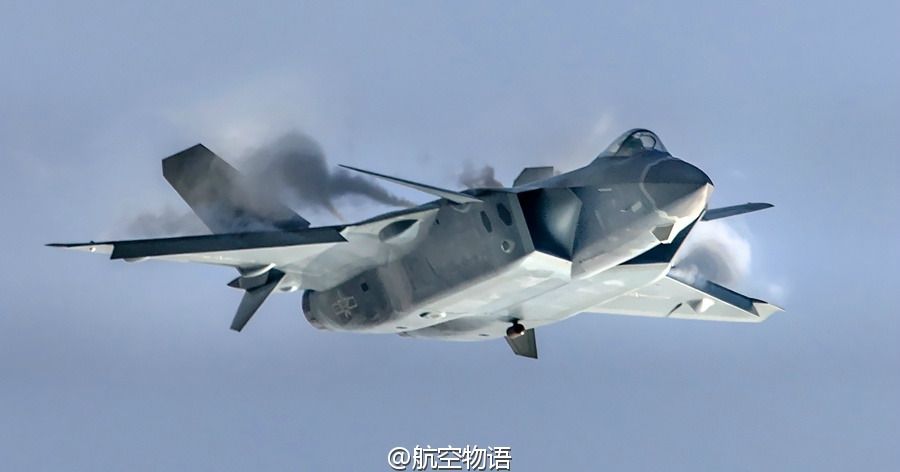
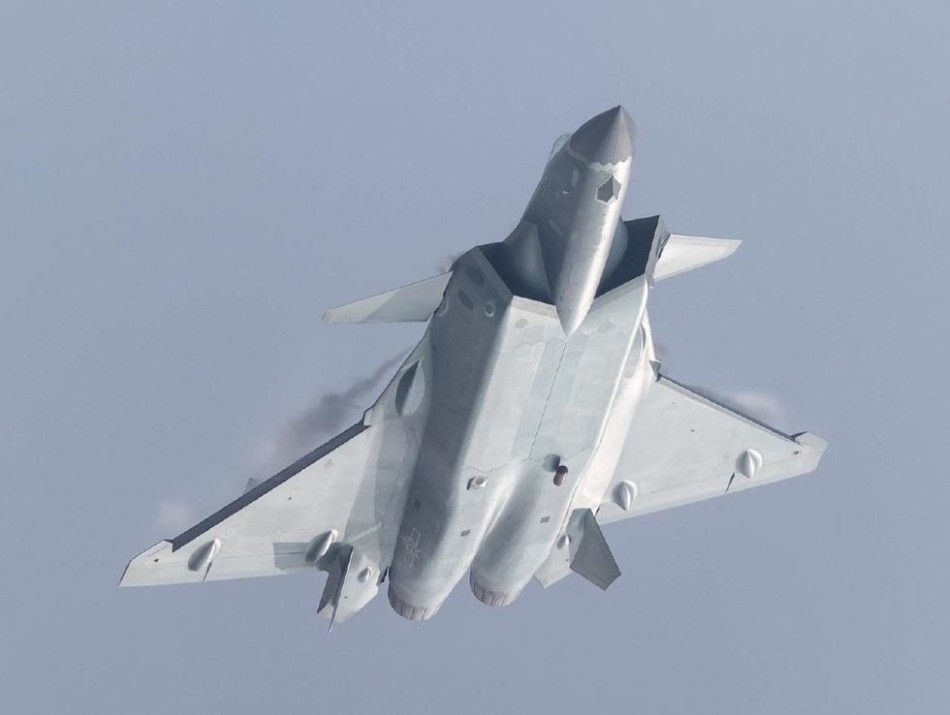
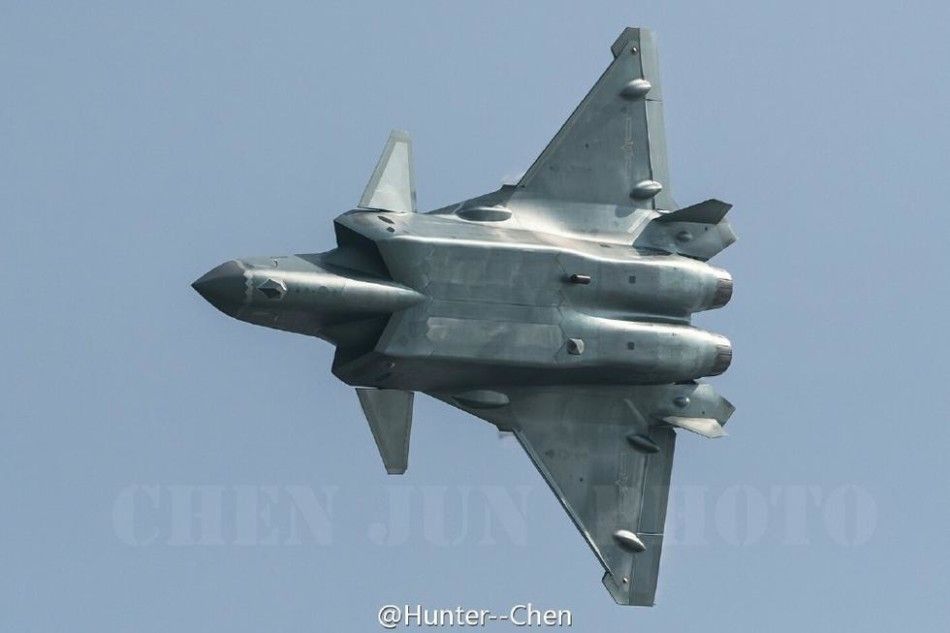
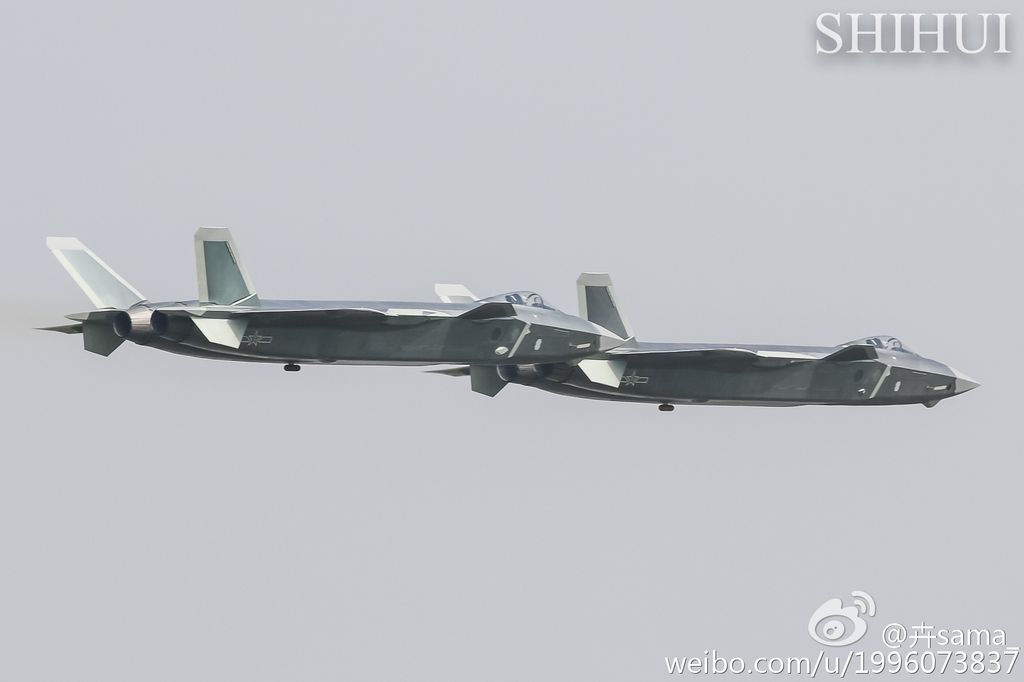
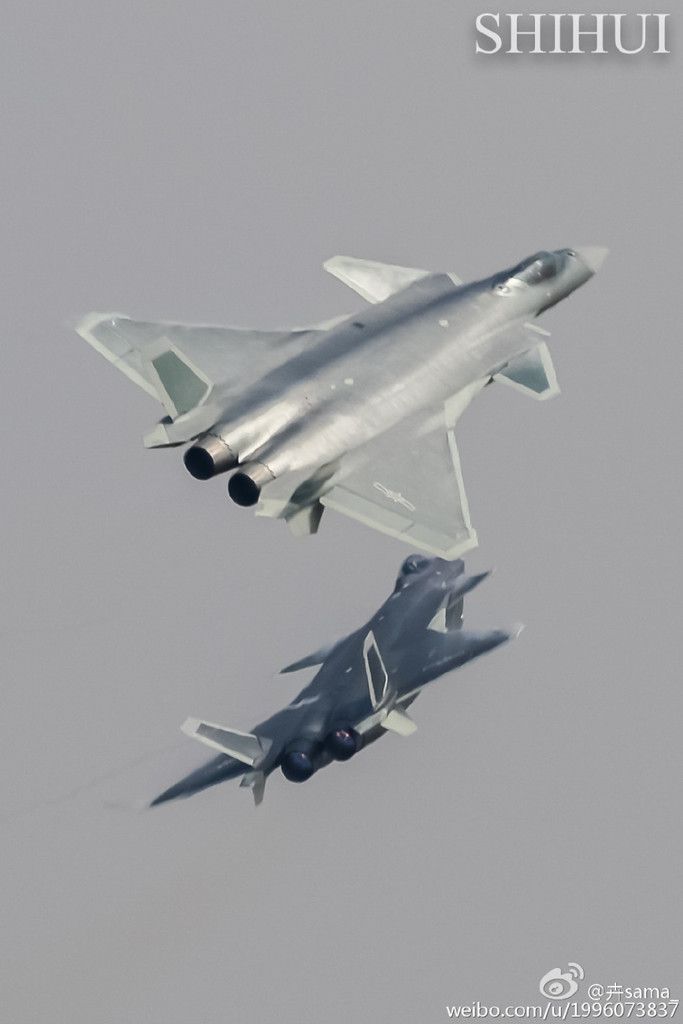
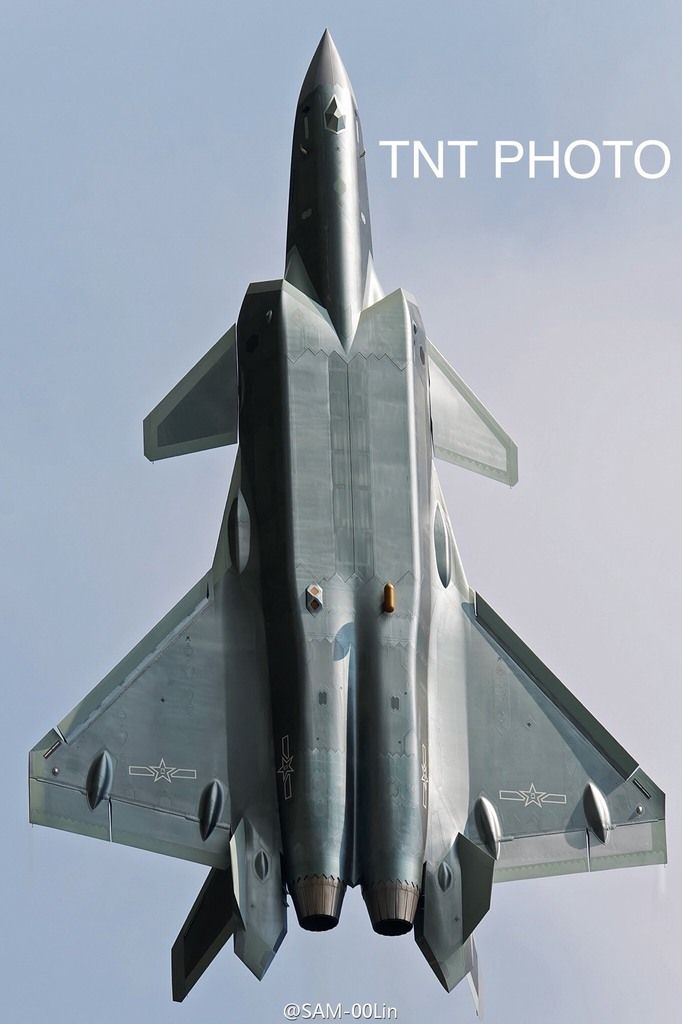






Yes it looks like the flight profile is restrictedAustin wrote: may be they have not released the entire FBW control or it might be in intermediate state of testing and they might not want to try any thing stupid that may lead to a crash or chance of crash and bad publicity ,

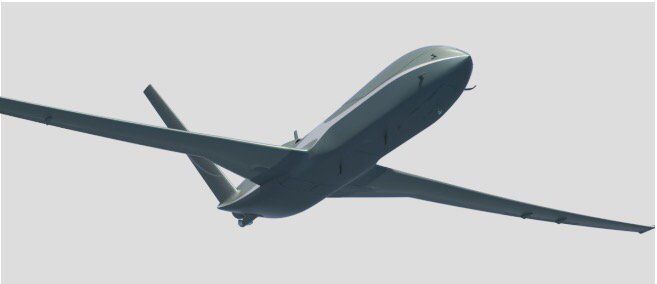
Yes, it looks stealthy. And yes we should buy the F-16 line if GOI decides we must go phoren.kit wrote:Good job by the Chinese !! .. It does look "stealthy" anyway i wonder if pouring money by India into a F16 tech is a good idea !!
It is black but it has 8 huge flat reflecting surfaces that look plenty unstealthy to me and huge hot engines at the back. Frontal stealth - probably yeskit wrote:Good job by the Chinese !! .. It does look "stealthy" anyway i wonder if pouring money by India into a F16 tech is a good idea !!
 [/quote]
[/quote]Indranil wrote:The Chinese surely love their vortices.
It's still single-piece, but with a supporting bar in the middle, just like the F-35's solution.hnair wrote:so that whole F22 style single-piece canopy is off?
Strike fighters don't need large movable canards. It was a tame performance, but it's really no tamer than the PLAAF J-10 performances, it's just how they usually do things.Austin wrote:The more I look at J-20 and its manouvering , The more I am made to believe the purpose of J-20 is primary of Heavy Class Strike Fighter with secondary capability of an Interceptor likely in 45 T MTOW category like Mig-31.
Mostly certainly it lacks the finness , agility and manouverability of Air Superiority fighter may be they have not released the entire FBW control or it might be in intermediate state of testing and they might not want to try any thing stupid that may lead to a crash or chance of crash and bad publicity , Much like when PAK-FA was displayed for first time in public 2011 its demonstration was sedate.
J-21 looks more like an Air Superiority Fighter in Medium Class
The problem is with the bays. They don't support the heavy strike fighter load. In fact the main bay looks like its designed around the carriage of 4 or 6 BVR weapons much like the F-22 and doesn't look deep enough to carry the heavy bombs or large diameter missiles like the F-35 does with the GBU-31 (2000 lb) or larger missiles like the AARGM-ER, JSM, SOM etc.The more I look at J-20 and its manouvering , The more I am made to believe the purpose of J-20 is primary of Heavy Class Strike Fighter with secondary capability of an Interceptor likely in 45 T MTOW category like Mig-31.

Also Zhuhai humidity at this time of year appears to be >60%Indranil wrote:The Chinese surely love their vortices.
I think the bays are big enough to accomodate the R-37 like missile even PAK-FA bays can so J-20 looks bigger to me , they can also design new weapons around the baysbrar_w wrote:The problem is with the bays. They don't support the heavy strike fighter load. In fact the main bay looks like its designed around the carriage of 4 or 6 BVR weapons much like the F-22 and doesn't look deep enough to carry the heavy bombs or large diameter missiles like the F-35 does with the GBU-31 (2000 lb) or larger missiles like the AARGM-ER, JSM, SOM etc.
Even as a pure range interceptor, the bays lack the capacity to accommodate something like the R-37 or the Aim-54. I think this is analogous to the F-22 for them within the limits of their design and propulsion capability. Neither long range strike, nor long range intercept is supported by the type of bays they have put on it. Not to mention that going high, going fast and staying LO is a very unique stress when it comes to materials, shaping and propulsion and is unlikely to be a high goal, especially when talking about a Mig-31 like capability with those intakes. The F-22 pays a heavy price in terms of cost to get low signature with a Mach 1.7 super-cruise speed. If you want to get even higher into a pure interceptor territory you'd add a ton more of design cost and complexity.
The Russians might not have the funds to finance their ideas in Russia but it's obvious they are selling their ideas and knowledge to the lizard.Singha wrote:if they are using the AL31 engine the engine bays look large enough to accomodate a bigger diameter..
only thing now between china and being a major #2 aerospace power is control over latest engine tech....airframe design at all levels looks good. Rus lack the $$ to fund the raft of new designs needed to hold the #2 ranking
Well,china has The reverse~engineered rd93,ws13.Austin wrote:The chinese just buy the engine much like we buy the F-404 for Tejas , The IAF was offered the RD-33 for Tejas but it preferred a Western Engine , AL-31 are just too big for any Indian fighter.
The Chinese have not been able to reverse engineer the engine probably due to alloy/metal composititon process involved etc , They also have huge access to Western Technology via Airbus and Boeing , The kind of order the Chinese give to Boeing and AIrbus they would just fall flat to give any thing to the chinese overt/covert.
Chinese also run extensive esponiage operation in West where they procure Technology/Knowhow , Accorinding to Pentagon onw recent estimate they have manged to compromise many data
http://freebeacon.com/national-security ... n-secrets/
In the end the Chinese know it is survival of fittest , if they dont do it then some one else .....The West too have extensive espionage operation inside china and its a fair game
R37 is about 15% longer, has 2 times the diameter and about 50% greater span than a standard AMRAAM class weapon. Even Sweetmann in his last analysis in 2014 estimated that the bay dimensions are actually very similar to the F-22. I simply don't see any room for any more than 2 such a2a weapons and they would actually take away any other medium ranged weapon that it could carry given their larger diameter and span.Austin wrote: I think the bays are big enough to accomodate the R-37 like missile even PAK-FA bays can so J-20 looks bigger to me , they can also design new weapons around the bays
BillSweetmann wrote:The J-20's wing and control surface layout is very different from that of the Lockheed Martin F-22, but the body layout is quite similar, with twin main weapon bays under the belly and side bays for rail-launched air-to-air missiles (AAMs), all located under and outside the inlet ducts. On both aircraft, the main landing gear is housed in the fuselage behind the weapon bays and the engines are close together. The big difference, however, is that the J-20 is 9.5 ft. (17%) longer than the F-22, from the nose to the engine nozzles. Most of this is in the widest part of the fuselage, and since the weapon bays are similar in size, it is almost all available for fuel
The J-20's weapon arrangement is similar to the F-22, except that the ventral bays are shorter and narrower, and are apparently capable of accommodating only four weapons the size of the SD-10 AAM. However, they do appear large enough to accommodate bigger folding-wing missiles-and China is reported to be negotiating to buy the Russian Kh-58UShKE, a Mach 4 anti-radar missile that is also intended for internal carriage on the T-50.
The side missile bays differ from those of the F-22 in that the doors can be closed after the missile rail has been extended, and have been seen with a missile-or test shape-with low-aspect-ratio wings and folding tails. So far, no gun has been seen on J-20s, nor has there been a sign of provision for one.
The J-20 design, therefore, is an air-to-air fighter with an emphasis on forward-aspect stealth, efficient highspeed aerodynamics and range, with a modest internal payload and more than adequate agility for self-defense.
The bay can hold 2 PL-12's on each side for a total of 4. How do you trade 4, 8 inch diameter weapons for 4, 15 inch diameter weapons in the same space? Also, check the length of the KH59. Same with the Harpoon. There you are talking about 4, 13.5 inch diameter missiles replacing 4, 8 inch diameter missiles in the same space.^ the bays imo could hold 4 x harpoon or KH59 sized weapons.


Those analysis can go wrong with so many morphed images going around the net , No one really knows how deep J-20 bays are really , I have seen few images of J-20 with weapon payload on the internet but all are just morphed perhaps made by fanbois .....We will have to wait for some official info.brar_w wrote:R37 is about 15% longer, has 2 times the diameter and about 50% greater span than a standard AMRAAM class weapon. Even Sweetmann in his last analysis in 2014 estimated that the bay dimensions are actually very similar to the F-22. I simply don't see any room for any more than 2 such a2a weapons and they would actually take away any other medium ranged weapon that it could carry given their larger diameter and span.

Right, and that can easily change as there is likely to be ways to squeeze in another PL-12 in there by developing something that fits a tighter form factor. The F-22 does it because the AMRAAM is a 7 inch diameter weapon and Raytheon and the folks at Atlantic Research Corporation were even able to engineer its VFDR inlets to accommodate the bays in case a ducted rocket motor path was pursued. The PL-12 is closer to 8 inch diameter so they may either have slightly wider bays or could potentially trim a new variant down to AMRAAM levels in the future. 4 or 6 MRAAM's isnt much of a concern as there are ways around is.It wont make much sense to design the biggest 5th Gen aircraft that can carry just 4 A2A missile. Any designer worth its money would try something more.
Jane's wrote:Published in the Chinese Journal of Aeronautics , the paper was written by six authors, including Yang Wei of the Chengdu Aircraft Design and Research Institute, who is the J-20's chief designer.
Entitled 'Aircraft vulnerability modelling and computation methods based on product structure and CATIA', the paper offers illustrations of a single-seat twin-engine canard-configuration aircraft based on the J-20.
However, the illustration shows an aircraft featuring a wider fuselage with a larger internal weapons bay, more widely separated turbofans and inward-canted vertical stabilisers mounted aft mid wing.



There was a brief but impressive show of new U.S. aircraft technology this week. The problem is that the planes belong to the Chinese military.
Aided in large part by espionage against the Pentagon and U.S. firms, the People's Liberation Army air force unveiled its new J-20 stealth fighter, which it says is a so-called fifth-generation fighter like the American F-22 and F-35. Two J-20s flew for just a few minutes at an airshow in Zhuhai on Tuesday, leaving military experts of two minds about what the J-20 is actually capable of.
QuickTake Territorial Disputes
While Bradley Perrett of Aviation Week warned it was "clearly a big step forward in Chinese combat capability," Greg Waldon of the consultancy FlightGlobal said the big reveal of the flyby was "we learned it was loud."
If the sparse details released by the Chinese and speculation of military insiders are accurate, the plane could present some problems should the cool war in the South China Sea heat up. The jet is said to have a longer range and more armament than the competing U.S. fighters, and while it doesn't likely have the computer systems to pose a threat to them, it could make easy targets of American refueling and surveillance craft.
But as far as U.S. officials are concerned, these capacities exist only in rumor. This is a common theme in all the Western fretting about China's cutting edge military prowess: Nobody knows whether any of it is real.
Consider the Chinese military's "carrier-killer missile," the DF-21D. It was unveiled last year, during China's celebrations marking the 70th anniversary of the end of World War II, amid a hype campaign calling it the fastest missile in the world. In the U.S. military, there is speculation that it has radar that can see over the horizon and a maneuverable warhead that allows precision guidance as it nears its target. This has some experts warning that the age of the American aircraft carrier is over.
But, again, there is little proof that this missile is real or that China has any of the capabilities that so worry the West. The same can be said of the YJ-12 missile, which is said to fly just above the surface of the water to avoid radar tracking. While we've seen these weapons in parades, demonstrations and airshows, the real question is what's inside. "Chinese 'hardware' continues to improve dramatically, but the caliber of the 'software' supporting and connecting it remains uncertain and untested in war," noted analyst Andrew Erickson in the National Interest. "The missile components of the DF-21D already are proven through multiple tests, but China's ability to use the missile against a moving target operating in the open ocean remains unproven."
Then there is the new Type 093B nuclear-powered attack submarine, which some fear may be as deadly as the U.S. Navy's Los Angeles-class boats. "The 93B is analogous to our LA improved in quietness and their appearance demonstrates that China is learning quickly about how to build a modern fast attack boat," according to Gary Hendrix of the Center for a New American Security. But high-ranking Navy officials are more sanguine, noting that in undersea warfare the Chinese approach has centered on quantity over quality -- Beijing is thought to have at least 70 attack subs, as compared to around 50 for the U.S. -- and the consensus among the top Pentagon brass is that China is unlikely to have made the leaps in technology some fear.
So what does this all mean for long-term U.S. strategy (beyond, of course, getting better at protecting our military secrets)? If we take the threat of Chinese advances seriously, the first step would be to take a tough look at plans to build 10 new Ford-class supercarriers, which would be quite vulnerable if the Chinese are really as far along as some fear. This doesn't mean giving up on carriers -- as forward-based platforms that don't rely on allies for hosting aircraft, they remain vital. But the wiser fiscal and preparedness choice may be stopping after the three supercarriers now under construction are completed and renovating five or so of the existing Nimitz-class, which are still far and away the terror of the seas. Through smarter management of maintenance and crew rotations, eight craft could conceivably do as effective a job patrolling the globe as the Navy's hoped-for 10. (Carriers will always, alas, be more vulnerable than fake islands.)
Another idea is to make the U.S. fleet more dispersed and effective through emphasizing "distributed-lethality warfare." This would involve making far more ships in the fleet -- including those responsible for reconnaissance, specialized missions such as mine dispersal, and protecting aircraft carriers -- capable of both striking the enemy and defending themselves. This gives the enemy more threats to protect against and more targets to eliminate. To some extent the Navy seems to be considering the approach; for example, it has upgraded the armor, weaponry and anti-torpedo capability of its troubled littoral combat ship.
Inevitably, long-term military thinking is an exercise in predicting what former Defense Secretary Donald Rumsfeld called known unknowns. The J-20 flyby showed only how little we know about China's drive to become a cutting-edge military.
This column does not necessarily reflect the opinion of the editorial board or Bloomberg LP and its owners.
To contact the author of this story: Tobin Harshaw at [email protected]
To contact the editor responsible for this story: Philip Gray at [email protected]
I haven't said that it can carry only 4. It could well carry 6 like others. It can also carry 2 ARM's and similarly sized strike weapons. Of ocurse more if you go down to SDB sizes. But where exactly will it carry 4 15 inch diameter weapons? The bay's can't magically grow wider, can they?brar_w you may have your point and perhaps you may be right but I would want to think the chinese are not stupid to build perhaps what looks like a 45 T plus fighter just to carry 4 weapons or not enough A2G weapons internally for a deep strike mission
You may not, but plenty of folks that have gone through this particular one have no objection to it not being accurate or point to it being morphed. There is really no image out there that shows the bays morphed to look narrower than they truly are. We even have a video of its bays open now.The absense of any official information leads to many partially correct analysis of its capability including Weapons bay , Tons of Morphed picture around and one will have tough time trying to find a needle in hay stack of which is the real one.
It may not widen or it may widen or get deeper depending on what comes out finally out of J-20 , Like you said they may just build new wepaons to accomodate more weapons but most certainly it wont be 4 AAM for such huge aircraftbrar_w wrote:I haven't said that it can carry only 4. It could well carry 6 like others. It can also carry 2 ARM's and similarly sized strike weapons. Of ocurse more if you go down to SDB sizes. But where exactly will it carry 4 15 inch diameter weapons? The bay's can't magically grow wider, can they?
BTW, how many Kh-58UShK's can the PAKFA/T-50 carry internally?
You may not, but plenty of folks that have gone through this particular one have no objection to it not being accurate or point to it being morphed. There is really no image out there that shows the bays morphed to look narrower than they truly are. We even have a video of its bays open now.[/quote]The absense of any official information leads to many partially correct analysis of its capability including Weapons bay , Tons of Morphed picture around and one will have tough time trying to find a needle in hay stack of which is the real one.
So it may widen..how wide can it go? Where's the space? Speculation aside, there is no way to fit 4 ARM's of the size being discussed in the current bay. You probably would also not be able to fit 2 15 inch diameter ARM's, along with 2 8 inch diameter AAM's. Just look at two 8 inch missiles side by side per half bay.It may not widen or it may widen or get deeper depending on what comes out finally out of J-20 , Like you said they may just build new wepaons to accomodate more weapons but most certainly it wont be 4 AAM for such huge aircraft
Singha wrote:So what advantage would it have over the cheaper and structurally more sleek j31 ? Sure more internal fuel but its large weight consume more fuel too?
I wonder if j31 is intended as the f22 and will enter volume run while j20 will morph in shape to a heavy strike fighter instead of being inducted as is...work could be ongoing in parallel. ..the f111 saw some role evolution in its life as did the f4 phantom
They are like heavy and medium fighter ,like how we have MKI & Rafale or FGFA/AMCASingha wrote:So what advantage would it have over the cheaper and structurally more sleek j31 ? Sure more internal fuel but its large weight consume more fuel too?
I wonder if j31 is intended as the f22 and will enter volume run while j20 will morph in shape to a heavy strike fighter instead of being inducted as is...work could be ongoing in parallel. ..the f111 saw some role evolution in its life as did the f4 phantom
Its a larger aircraft, probably performs better given it was selected as the winner of the design competition. Range is a value add. You also have to take everything into account particularly range and total payload (internal and external). A high internal fuel volume on account or range with signature requirements also translates to excellent range when loaded with external ordinance since you don't have to go for bags. Room for larger sensors, multi-role optimized bays etc etc.So what advantage would it have over the cheaper and structurally more sleek j31 ? Sure more internal fuel but its large weight consume more fuel too?
